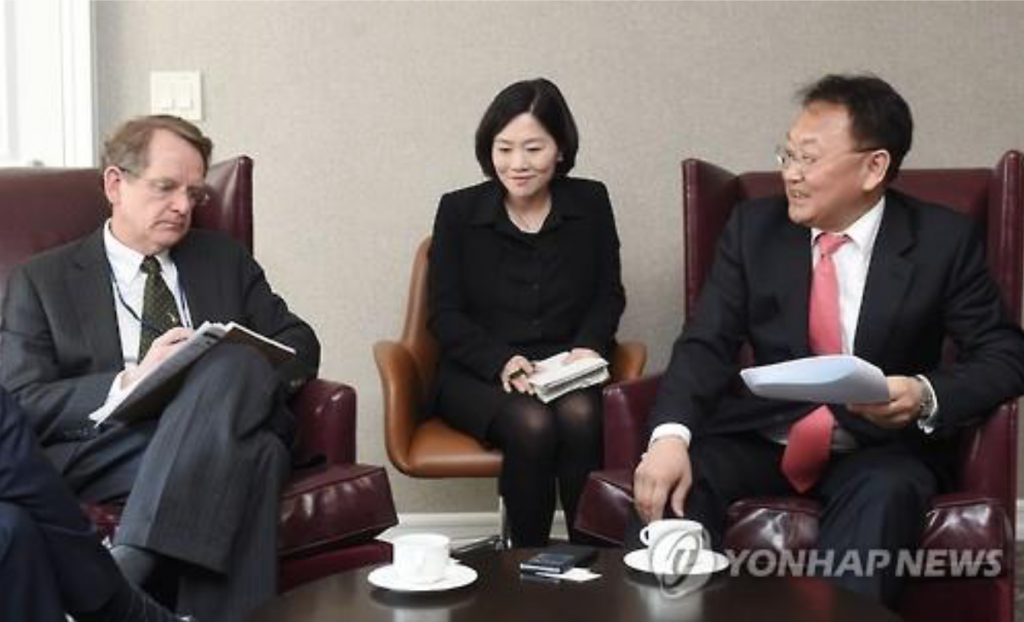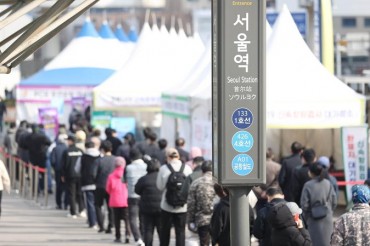
South Korean Finance Minister Yoo Il-ho meets with an official of S&P in Washington in April 15, 2016. (image: Yonhap)
SEJONG, Aug. 8 (Korea Bizwire) – Global credit appraiser Standard & Poor’s (S&P) raised South Korea’s sovereign rating one notch to a record high of AA from AA- on Monday, with a stable outlook on the country’s steady growth and flexible fiscal and monetary policies.
“The upgrade reflects our assessment that Korea’s strong record of steady growth has generated a prosperous economy, greater fiscal and monetary flexibility, and continual improvements in external metrics,” the company said in a statement.
“Our ratings on Korea reflects the country’s favorable policy environment, sound fiscal position and net external creditor position. Significant security risks and contingent fiscal liabilities partly offset these strengths.”
AA is the third highest grade in the S&P evaluation scheme and is possessed by France, Belgium and Britain, placing South Korea one level higher than China and two higher than Japan.
It is the second time in a year that S&P has upgraded the country’s sovereign rating, and comes less than a year since the last upgrade to AA- in September last year.
S&P said Asia’s fourth-largest economy has outperformed other high-income economies in recent years, with its real per capita gross domestic product (GDP) growing 2.6 percent, higher than the average 0.3-1.5 percent growth range of advanced countries. It expected South Korea’s GDP per capita to reach US$30,000 in 2019, up from an estimated $27,000 in 2016.
The agency noted that the country’s economy has remained diversified enough to depend less on one particular industry of the export market, as faltering exports will rebound in the future on the back of a recovery in the United States.
“A recovery in the U.S. economy should provide support for Korean exports, partly offsetting weaker exports to China,” it said.
South Korea’s outbound shipments, regarded as one of the key economic drivers, have fallen every single month since January last year due mainly to decreased global demand and low oil prices.
The downbeat exports trend, coupled with on-going corporate restructuring of the shipbuilding and steel industries, has weighed heavily on the country, which expanded 2.6 percent last year and is projected to post 2.7-percent growth in 2016.
In order to tackle the downside pressure, the Seoul government has churned out a series of stimulus packages to boost the economy, including 11 trillion won worth of extra budgets, while the central bank has cut the base rate several times to reach a record low of 1.25 percent.
“Korea’s monetary policy regime provides strong support for resilient and sustainable economic growth,” S&P said. “The Bank of Korea has maintained an accommodative stance in alignment with fiscal policy.”
S&P also pointed out that South Korea’s healthy fiscal position helped the country get a rate upgrade, citing that the country’s government debt remained modest at around 20 percent of the GDP in 2015.
Geopolitical risks, especially provocations from North Korea, however, are regarded as the chief weaknesses in South Korea’s credit fundamentals due to lingering uncertainties and the possible cost of reunification, the company noted.
“The stable outlook on the long-term ratings is predicted on our expectation that longstanding geopolitical risks will not escalate materially to the point of damaging Korea’s credit metrics,” S&P said. “We expect the rating to remain unchanged over the next two years.”
The finance ministry of South Korea anticipated that the latest upgrade will contribute to stabilizing the local financial market in the face of a possible U.S. rate hike and a slowdown in China.
“The upgrade will help local financial firms and public companies see their credit ratings hike in the future,” the ministry said.
(Yonhap)






